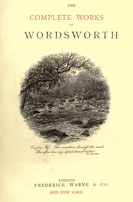The Complete Works of Wordsworth
“The books on the white wooden shelves were arranged from below upwards according to bulk. A complete Wordsworth stood at one end of the lowest shelf and a copy of the Maynooth Catechism, sewn into the cloth cover of a notebook, stood at one end of the top shelf.”
-“A Painful Case” (D 107-8)
James Duffy organizes his books according to size. He places the largest books on the lowest shelf and the smallest on the top. This is a sensible strategy for a number of reasons. If the heaviest books anchor the shelves at the bottom, the whole bookcase is more stable and less likely to topple. Placing books on a shelf next to volumes of a similar size also offers support for the books themselves. Samuel Pepys, most famously, employed this method, numbering his entire entire collection from largest to smallest. The fastidious and stable organization of Duffy’s library reflects his sensibility before meeting with Mrs. Sinico. The exchange of books speaks to their intimacy and its tragic interruption. After describing the increasing frequency of their meetings, Joyce notes the intellectual and material entanglements that unite the two: “Little by little he entangled his thoughts with hers. He lent her books, provided her with ideas, shared his intellectual life with her” (D 110). Duffy disrupts the unity and order of his library to cement his relationship with Mrs. Sinico through the exchange of books. This move is more risky than it seems. As one contemporary bibliophile remarked, “Borrowers, of course, are nearly the worst enemies of books, always careless, and very apt to lose one volume out of a set” (Humphreys 17). Only days after dissolving their relationship, Duffy “receives a parcel containing his books and music,” and he “returned to his even way of life” (D 112). The physical placement and exchanges of his volumes reveals his domestic situation and changing relationship to Mrs. Sinico.
The collections of Wordsworth’s complete works on the market in the final decades of the nineteenth century spanned hundreds of pages. Macmillan’s The Complete Poetical Works of William Wordsworth (1888) encompasses over 1,100 pages of verse and supplementary material while Frederick Warne & Co.’s The Complete Works of Wordsworth (1889), which did not include The Prelude because of copyright issues, ran over 600 pages.
Joyce ranked Wordsworth among the first-rate English writers, and cited his poem “The Affliction of Margaret” as evidence of his genius (JJ 204-5). Duffy gives Wordsworth the honor of being the largest book in his library.

